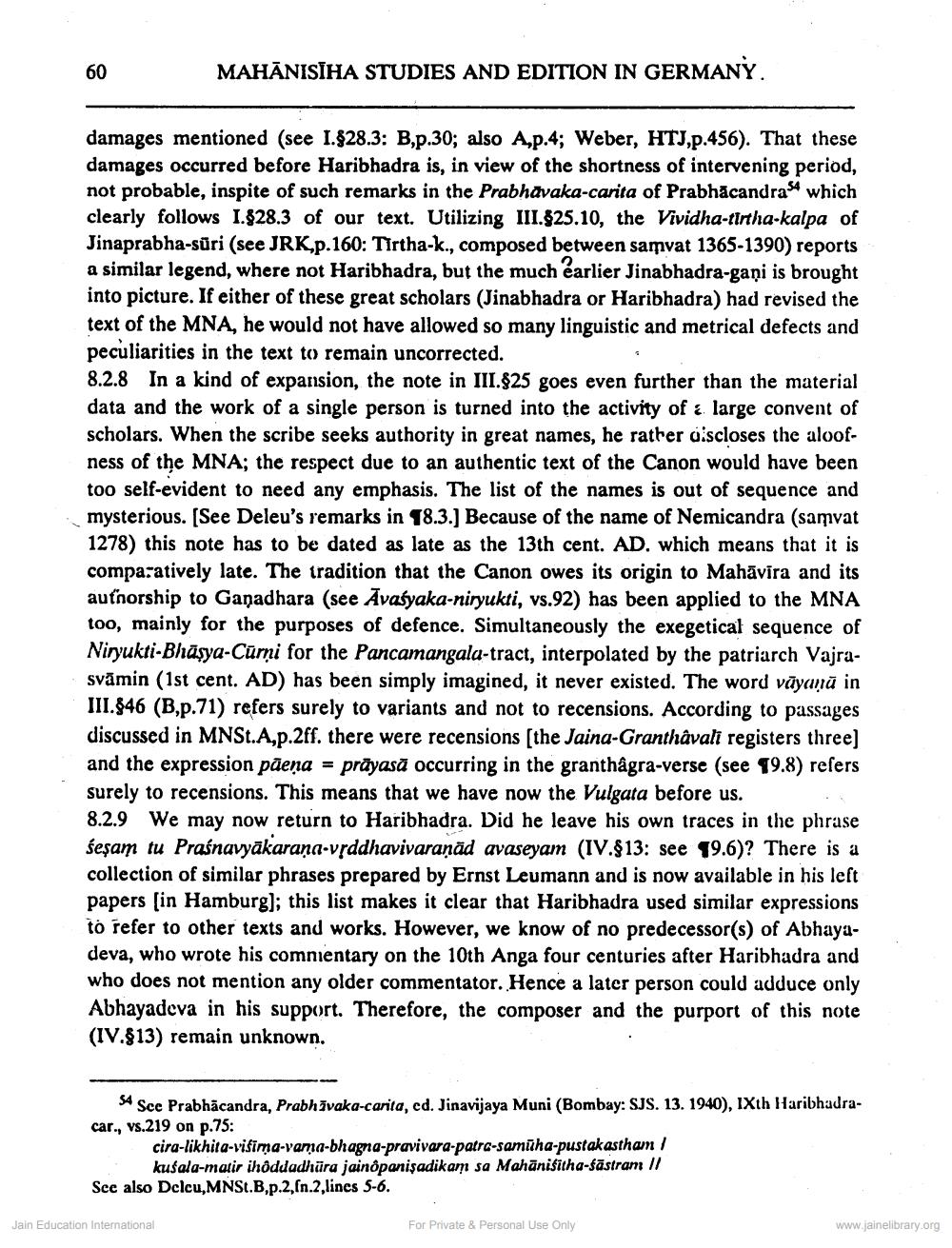________________
60
MAHĀNISĪHA STUDIES AND EDITION IN GERMANY.
damages mentioned (see 1.828.3: B,p.30; also A,p.4; Weber, HTJ,p.456). That these damages occurred before Haribhadra is, in view of the shortness of intervening period, not probable, inspite of such remarks in the Prabhavaka-carita of Prabhācandrash which clearly follows 1.828.3 of our text. Utilizing III.325.10, the Vividha-tirtha-kalpa of Jinaprabha-sűri (see JRK,p.160: Tirtha-k., composed between samvat 1365-1390) reports a similar legend, where not Haribhadra, but the much earlier Jinabhadra-gani is brought into picture. If either of these great scholars (Jinabhadra or Haribhadra) had revised the text of the MNA, he would not have allowed so many linguistic and metrical defects and peculiarities in the text to remain uncorrected. 8.2.8 In a kind of expansion, the note in III.825 goes even further than the material data and the work of a single person is turned into the activity of large convent of scholars. When the scribe seeks authority in great names, he rather oscloses the aloofness of the MNA; the respect due to an authentic text of the Canon would have been too self-evident to need any emphasis. The list of the names is out of sequence and mysterious. (See Deleu's remarks in 18.3.) Because of the name of Nemicandra (samvat 1278) this note has to be dated as late as the 13th cent. AD. which means that it is comparatively late. The tradition that the Canon owes its origin to Mahāvīra and its authorship to Ganadhara (see Āvasyaka-niryukti, vs.92) has been applied to the MNA too, mainly for the purposes of defence. Simultaneously the exegetical sequence of Niryukti-Bhāşya-Curņi for the Pancamangala-tract, interpolated by the patriarch Vajrasvāmin (1st cent. AD) has been simply imagined, it never existed. The word vāyaṇā in III.846 (B,p.71) refers surely to variants and not to recensions. According to passages discussed in MNSt.A,p.2ff. there were recensions (the Jaina-Granthâvali registers three) and the expression pāeņa = prāyasă occurring in the granthågra-verse (see 19.8) refers surely to recensions. This means that we have now the Vulgata before us. 8.2.9 We may now return to Haribhadra. Did he leave his own traces in the phrase śeşam tu Praśnavyākarana-vrddhavivaraņād avaseyam (IV.813: see 89.6)? There is a collection of similar phrases prepared by Ernst Leumann and is now available in his left papers (in Hamburg); this list makes it clear that Haribhadra used similar expressions to refer to other texts and works. However, we know of no predecessor(s) of Abhayadeva, who wrote his comnientary on the 10th Anga four centuries after Haribhadra and who does not mention any older commentator. Hence a later person could adduce only Abhayadeva in his support. Therefore, the composer and the purport of this note (IV.813) remain unknown.
Sce Prabhācandra, Prabhāvaka-carita, cd. Jinavijaya Muni (Bombay: SJS. 13. 1940), IXth Haribhadracar., vs.219 on p.75:
cira-likhita-vifima-vamma-bhagna-pravivara-patro-samūha-pustakastham /
kusala-matir ihôddadhüra jainôpanişadikam sa Mahānisitha-fāstram // See also Delcu, MNSt.B.p.2, (n.2, lincs 5-6.
Jain Education International
For Private & Personal Use Only
www.jainelibrary.org




